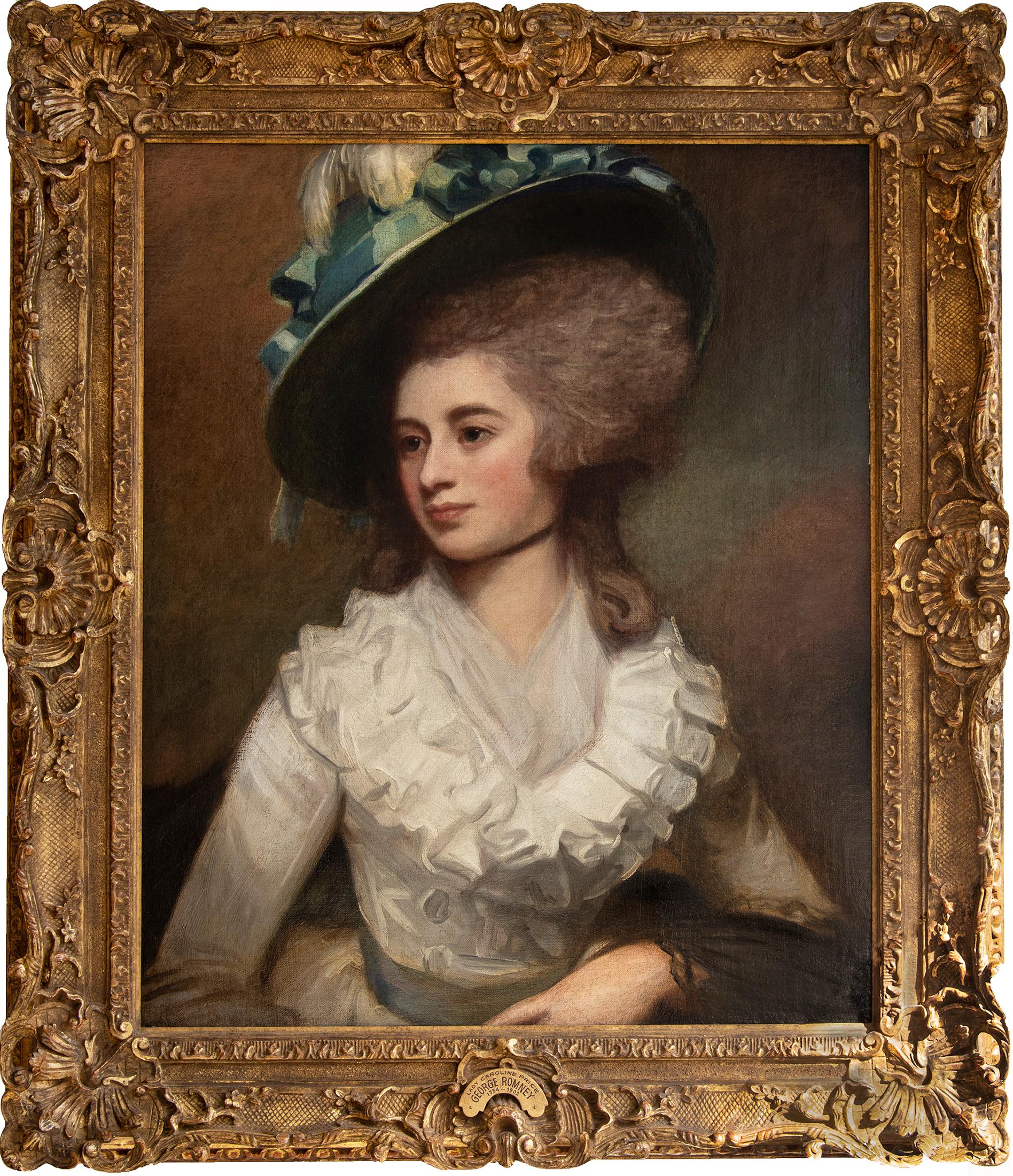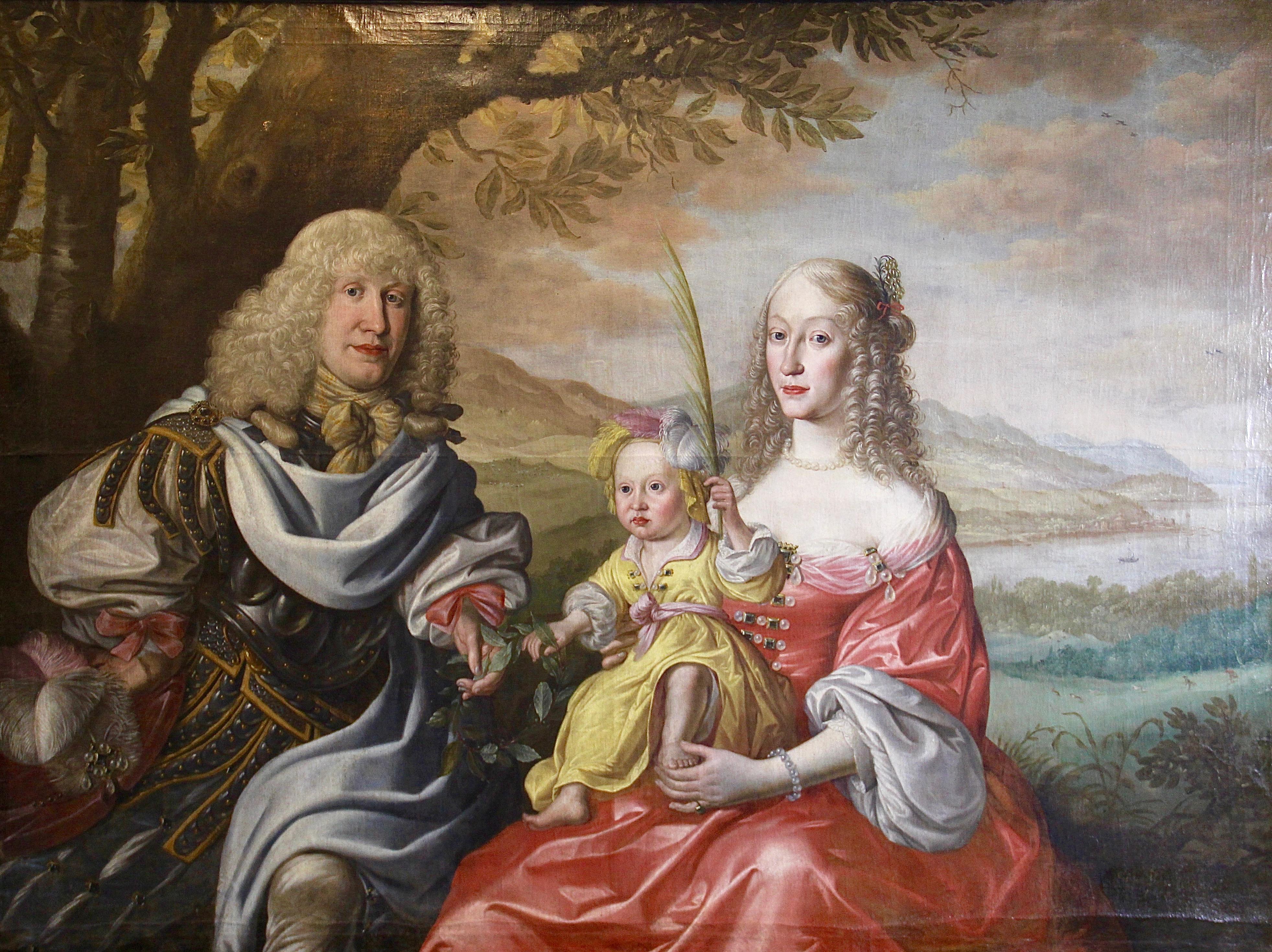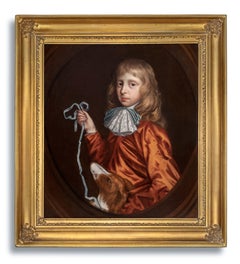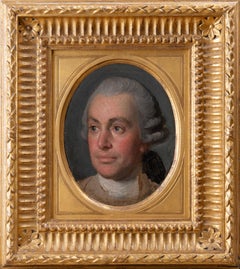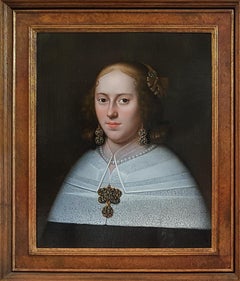
Dutch School Portrait of Brigitta de Groot (1659-1686), Lady Antique Painting
View Similar Items
Want more images or videos?
Request additional images or videos from the seller
1 of 5
attributed to Abraham LiedtsDutch School Portrait of Brigitta de Groot (1659-1686), Lady Antique PaintingCirca 1659
Circa 1659
About the Item
- Creator:attributed to Abraham Liedts (Dutch)
- Creation Year:Circa 1659
- Dimensions:Height: 27.56 in (70 cm)Width: 23.63 in (60 cm)
- Medium:
- Movement & Style:
- Period:Mid-17th Century
- Condition:The condition is excellent (both painting and frame) and ready to hang and enjoy.
- Gallery Location:London, GB
- Reference Number:1stDibs: LU119914348331
About the Seller
5.0
Platinum Seller
These expertly vetted sellers are 1stDibs' most experienced sellers and are rated highest by our customers.
Established in 1998
1stDibs seller since 2019
31 sales on 1stDibs
More From This SellerView All
- Portrait of Lady, Grace Saunderson, Viscountess Castleton Oil on canvas PaintingBy Studio of Sir Peter LelyLocated in London, GBPortrait of Grace Saunderson, Viscountess Castleton (1635-1667) c.1665-67 Sir Peter Lely and Studio (1618-1680) Titan Fine Art present this work, which formed part of a collection of family pictures and heirlooms of the Saunderson, Viscount Castleton family and their descendants, the Earls of Scarbrough, at their magnificent family seat Sandbeck Park, where the Earls still reside today almost four hundred years later. It was painted in the studio of Sir Peter Lely...Category
17th Century Old Masters Portrait Paintings
MaterialsCanvas, Oil
- Portrait of a Gentleman in Armour and Holding a Baton, Manor House ProvenenceLocated in London, GBTitan Fine Art present this accomplished work, from Kilcooley Abbey, Co Tipperary, Ireland. It portrays a gentleman traditionally known as the English military commander and politic...Category
17th Century Old Masters Portrait Paintings
MaterialsCanvas, Oil
- Portrait of a Young Gentleman and Pet Dog c.1680, Antique oil on Canvas PaintingBy (Circle of) Mary BealeLocated in London, GBThe portrait genre was valued particularly highly in English society. Neither landscapes nor allegorical pictures were ever priced so highly at exhibitions and in the trade as depictions of people, from the highest aristocracy to scholars, writers, poets and statesmen. This charming portrait, presented by Titan Fine Art, of a fashionable young gentleman and his faithful pet is an excellent example of 17th century child portraiture in England. There is a remarkable beauty and sensitivity to the portrait. The face, particularly well rendered, has captured the character of this young man – both charming and at the same time mischievous. Only the playful attention of a small dog suggests anything less than patrician dignity. Symbolism was important in portraiture and it provided a pointed and aspirational narrative that would not have been lost on contemporary viewers. For example, the presence of the dog, which was likely the boy’s pet, is at once a charming pictorial device and also a clear allusion to fidelity, trust and loyalty. The hairstyle and the attire, notably the type of cravat with the blue ribbon, help to date this portrait to between 1670 to 1685. Until the late eighteenth century children were dressed as adults - boys were dressed like men in breeches, vests, and coats between four and seven years of age. The expensive lace is an indication to his family’s wealth. Held in a good quality and condition antique gilded frame. Born in Suffolk, Mary Beale, nee Cradock (1633-1699) was employed by many of the most distinguished persons of her time including nobility, landed gentry, and clergymen. Technically accomplished, her paintings are noteworthy for their honest and sympathetic portrayal. In 1651 she married Charles Beale...Category
17th Century Old Masters Portrait Paintings
MaterialsCanvas, Oil
- Portrait of Abigail, Countess of Kinnoull, Signed Dated Godfrey Kneller PaintingBy Kneller GodfreyLocated in London, GBPresented by Titan Fine Art, this elegant and beautiful portrait depicts Abigail Hay, Lady Dupplin, Countess of Kinnoull; it is an excellent example of English portraiture from the f...Category
18th Century Old Masters Portrait Paintings
MaterialsCanvas, Oil
- Grand-Scale Old Master Garland Portrait, 17th Century, Signed & Dated, Rare workLocated in London, GBIndistinctly signed and dated In the first quarter of the 17th century a new form of flower painting was developed in Flemish painting, which, recreated by a large group of artists and workshops, would achieve considerable success throughout the century in much of Europe: the garland of flowers surrounding a central figure. Brueghel de Velurs was the initiator of this type of composition, however, it was his pupil, Daniel Seghers, who was the dominant figure in this specialised production and the creator of a prototype that would serve as a model for the numerous artists who followed in his wake. It seems undeniable that the artist of the present painting had seen the Garlands of Flowers Surrounding a Medallion Depicting the Triumph of Love by Daniel Seghers and Domenico Zampieri (now in the Musée du Louvre in Paris). In our painting, the present floral wreath encircles a carved cartouche within which sits Saint Dorothy of Caesarea and the attribute which often accompanies her in art, a basket of roses. The extremely delicate flowers have been rendered in meticulous detail, so that every species can be identified from exotic tulips to roses, irises and forget-me-nots; this obvious attention to naturalism is inherited from the Flemish manner. Each flower is so precise and refined that they are an individual study in their own right. The still-lifes are from the hand of Jan Anton van den Baren, with the central figures by another accomplished hand. Van den Baren’s arrangement of flowers would have delighted connoisseurs in both Flanders and in Vienna, where the impossibility of their all blooming at the same time of year would have been understood as a further statement of the wonder and beauty of the divine. Van den Baren worked first in Brussels, where he collaborated with Erasmus Quellinus II for the figures in his works, before moving with Archduke Leopold Wilhelm, his patron, to Vienna in 1656, where he instead worked with fellow Flemish émigré painter Nikolaus van Hoy. The iconography relates to an eighth century legend where she was presented a basket of roses by a child. In addition to the brilliance of his handling of still-lifes Van den Baren played an important art historical role as Director of Archduke Leopold Wilhelm’s Picture Gallery in Vienna, then one of the greatest collections in the world and the core of what was to become the present collection of the Kunsthistorisches Museum, Vienna. Van der Baren compiled an inventory of the collection in 1659, and his predecessor as Director of the Archduke’s Picture Gallery (when it was still housed in Flanders), David Teniers, depicted van der Baren (third from right) in his celebrated Archduke Leopold Willem in his gallery at Brussels, conserved at the Kunsthistorisches Museum. It is a shining example of the Flemish Baroque and is a very rare object indeed, considering there are only 14 paintings accepted as authentic works by this artist. We are grateful to Fred Meijer for confirming the attribution to Johannes Antonius van der Baren. A feature of this painting is its outstanding carved and gilded frame with a plethora of flowers and foliage. Titan Fine ArtCategory
17th Century Old Masters Portrait Paintings
MaterialsCanvas, Oil
- Double Portrait of Sir John Rivers 3rd Baronet of Chafford, and Lady Anne RiversLocated in London, GBThis magnificent grand-scale work, offered by Titan Fine Art, formed part of a collection of family pictures and heirlooms of the Rivers Baronets and their descendants for over 325 years, before it was dispersed by the last in the line in 1988. The work was painted by the most technically proficient painter in England after the death of Van Dyck, and the dominant court painter to Charles II and James, Duke of York, Sir Peter Lely. It is no surprise that for years Lely had no serious rivals, was enormously influential and successful, and one of the country’s most important painters – and his work influenced countless artists over generations. The exquisite carved and gilded auricular frame is an astounding work of art in itself. The sitters in this exquisite double portrait are Sir John Rivers, who succeeded as the 3rd Baronet Chafford in 1657 (c.1638 - c. 1679), and his wife, Lady Anne Hewitt (c.1640-c.1689). They are seated in an outdoor setting beside a fountain modelled as a female figure with water issuing into a scallop-shell. The water, the elaborate sculpted fountain with its scallop-edged bowl, and the open shell in her hand are symbols of fertility - as such they make an appropriate allusion to Lady Anne’s potential as wife and mother, recalling Proverbs, chapter 5, verse 18: “Let thye fountain be blessed, and rejoice in the wife of thye youth”. This reference was realised, as Sir John and Lady Anne produced at least six children; their son George (1665-1734) became 4th Baronet of Chafford. The composition, thus, represents a celebration of marriage and was likely commissioned around the time of the betrothal (the marriage took place 26th Feb 1662 or 1663). The statues in the left margin are 'Youth and 'Old Age' and are a typical form of Memento Mori reminding virile young man that even they will lose their youth and grow old. The Rivers family, originally of Kent, traces its history to Sir Bartholomew Rivers, in the reign of Edward IV. The family included several prominent members including several knights, a Commander in the King's Army, a steward of a ducal estate, a Lord-Mayor of London, and an M.P. John Rivers (c.1659-c.1651) was made 1st Baronet of Chafford in 1622 by King James I. The Chafford estate was the family seat and it remained so until the early 1700s with the death of Sir George Rivers, 4th Baronet (1665–1734), whose sons had all died. The Chafford estate was left to his daughters while the baronetcy passed to nephew John Rivers, 5th Baronet (c. 1718–1743), and then Sir John’s brother, Sir Peter Rivers-Gay, 6th Baronet (c. 1721–1790). Upon Sir Peter Rivers Gay's death the estate passed to his eldest son, Sir Thomas Rivers Gay, 7th Baronet (c. 1770–1805). Sir Thomas, dying in 1805 with no children, bequeathed the estate to his mother Dame Martha Rivers Gay, who managed the estate until 1834 when she settled it on the then Sir Henry Rivers, 9th Baronet (c. 1779–1851) her younger son, before dying shortly thereafter in 1835. Sir Henry had married in 1812 to Charlotte Eales, with whom he had 6 sons and 8 daughters. Upon his death in 1851 the estate passed to his eldest surviving son Sir James Francis Rivers, 10th Baronet (1822–1869). Sir James married Catherine Eastcott in 1867 but died childless in 1869, and the estate passed to his only surviving brother Sir Henry Chandos Rivers, 11th Baronet (1834–1870) but he died a year later in 1870 also childless; with no male heir the Baronetcy was therefore extinguished. The estate was bequeathed, in trust, by Sir Henry Chandos Rivers to Thomas Frederick Inman, a solicitor of Bath, who then managed the estate as a trustee on behalf of Sir Henry Chandos Rivers' sister Katherine Rivers (c.1826-1895). It then passed to Katherine River’s daughter, Katherine Wall (born c.1855), who had also inherited Worthy Park House from her father, George Alfred Ellis Wall (1825-1875). Until 1958 our portrait is known to have hung at Worthy Park House. Upon Katherine Wall’s death, the Rivers estate passed to her daughter, Katherine Eleonora Rivers Fryer (1889-1963), who married Colonel James Alexander Butchart 1877-1853. In 1958 the family sold Worthy Park House but our portrait was loaned to Southampton Museum and Art Gallery. After the death of Katherine and Colonel James, the estate was left to their only son, Charles Bruce Rivers Butchart (1917-2005) and upon Charles’ retirement to a nursing home in 1988, and without heirs, our portrait, along with the residual assets of the Rivers estate were sold, thus ending over 325 years of continual family ownership. Lady Anne Rivers is thought to have been born circa 1640. She was the fourth child of the second marriage of Sir Thomas Hewitt (or Hewett) (1606-1662), 1st Baronet of Pishobury, Herts, and his wife Margaret Lytton (died 1689). Sir Thomas was an English landowner and M.P. for Windsor and upon the English Restoration...Category
17th Century Old Masters Portrait Paintings
MaterialsCanvas, Oil
You May Also Like
- Portrait of a Lady with a ChiqueadorLocated in New York, NYProvenance: Torres Family Collection, Asunción, Paraguay, ca. 1967-2017 While the genre of portraiture flourished in the New World, very few examples of early Spanish colonial portraits have survived to the present day. This remarkable painting is a rare example of female portraiture, depicting a member of the highest echelons of society in Cuzco during the last quarter of the 17th century. Its most distinctive feature is the false beauty mark (called a chiqueador) that the sitter wears on her left temple. Chiqueadores served both a cosmetic and medicinal function. In addition to beautifying their wearers, these silk or velvet pouches often contained medicinal herbs thought to cure headaches. This painting depicts an unidentified lady from the Creole elite in Cuzco. Her formal posture and black costume are both typical of the established conventions of period portraiture and in line with the severe fashion of the Spanish court under the reign of Charles II, which remained current until the 18th century. She is shown in three-quarter profile, her long braids tied with soft pink bows and decorated with quatrefoil flowers, likely made of silver. Her facial features are idealized and rendered with great subtly, particularly in the rosy cheeks. While this portrait lacks the conventional coat of arms or cartouche that identifies the sitter, her high status is made clear by the wealth of jewels and luxury materials present in the painting. She is placed in an interior, set off against the red velvet curtain tied in the middle with a knot on her right, and the table covered with gold-trimmed red velvet cloth at the left. The sitter wears a four-tier pearl necklace with a knot in the center with matching three-tiered pearl bracelets and a cross-shaped earing with three increasingly large pearls. She also has several gold and silver rings on both hands—one holds a pair of silver gloves with red lining and the other is posed on a golden metal box, possibly a jewelry box. The materials of her costume are also of the highest quality, particularly the white lace trim of her wide neckline and circular cuffs. The historical moment in which this painting was produced was particularly rich in commissions of this kind. Following his arrival in Cuzco from Spain in the early 1670’s, bishop Manuel de Mollinedo y Angulo actively promoted the emergence of a distinctive regional school of painting in the city. Additionally, with the increase of wealth and economic prosperity in the New World, portraits quickly became a way for the growing elite class to celebrate their place in society and to preserve their memory. Portraits like this one would have been prominently displayed in a family’s home, perhaps in a dynastic portrait gallery. We are grateful to Professor Luis Eduardo Wuffarden for his assistance cataloguing this painting on the basis of high-resolution images. He has written that “the sober palette of the canvas, the quality of the pigments, the degree of aging, and the craquelure pattern on the painting layer confirm it to be an authentic and representative work of the Cuzco school of painting...Category
17th Century Old Masters Paintings
MaterialsCanvas, Oil
- Italian Greyhound and Friends - Italian 17thC Old Master dog art oil paintingBy Francesco FieravinoLocated in London, GBThis stunning Old Master 17th century oil portrait painting is attributed to Francesco Fieravino, an artist famous in his day for still lifes and carpets. This painting which dates t...Category
17th Century Old Masters Animal Paintings
MaterialsCanvas, Oil
- 18th century portrait of the painter Nathaniel DanceLocated in London, GBCollections: Robert Gallon (1845-1925); Private Collection, UK. Oil on canvas laid down on panel Framed dimensions: 11.5 x 10 inches This highly engaging, previously unpublished portrait by Johan...Category
18th Century Old Masters Portrait Paintings
MaterialsOil, Wood Panel, Canvas
- Head of an AngelLocated in New York, NYProcaccini was born in Bologna, but his family moved to Milan when the artist was eleven years old. His artistic education was evidently familial— from his father Ercole and his elder brothers Camillo and Carlo Antonio, all painters—but his career began as a sculptor, and at an early age: his first known commission, a sculpted saint for the Duomo of Milan, came when he was only seventeen years old. Procaccini’s earliest documented painting, the Pietà for the Church of Santa Maria presso San Celso in Milan, was completed by 1604. By this time the artist had made the trip to Parma recorded by his biographers, where he studied Correggio, Mazzola Bedoli, and especially Parmigianino; reflections of their work are apparent throughout Procaccini's career. As Dr. Hugh Brigstocke has recently indicated, the present oil sketch is preparatory for the figure of the angel seen between the heads of the Virgin and St. Charles Borrommeo in Procaccini's altarpiece in the Church of Santa Afra in Brescia (ill. in Il Seicento Lombardo; Catalogo dei dipinti e delle sculture, exh. cat. Milan 1973, no. 98, pl. 113). As such it is the only known oil sketch of Procaccini's that can be directly connected with an extant altarpiece. The finished canvas, The Virgin and Child with Saints Charles Borrommeo and Latino with Angels, remains in the church for which it was painted; it is one of the most significant works of Procaccini's maturity and is generally dated after the artist's trip to Genoa in 1618. The Head of an Angel is an immediate study, no doubt taken from life, but one stylistically suffused with strong echoes of Correggio and Leonardo. Luigi Lanzi, writing of the completed altarpiece in 1796, specifically commented on Procaccini's indebtedness to Correggio (as well as the expressions of the angels) here: “Di Giulio Cesare...Category
17th Century Old Masters Figurative Paintings
MaterialsPaper, Canvas, Oil
- Portrait of a Young BoyLocated in New York, NYSigned and dated, lower left: Louise Hersent/ 1823 Provenance: Private Collection, Chicago, by 1996 Private Collection, Florida This charming portrait of a young boy is the work of Louise-Marie-Jeanne Hersent, a little-known woman artist of the French Restoration often identified by her maiden name, Mauduit. While Hersent—as we will call her here following the signature on the painting—has been understudied, the known details of her life and career reveal that she held a privileged position in artistic life in the early nineteenth century in Paris. She exhibited at the Salon from 1810 until 1824, and in 1821 she married the painter Louis Hersent, a successful pupil of Jacques-Louis David who was patronized by Louis XVIII and Charles X. It is likely through her husband’s royal patronage that Hersent’s Louis XIV Visits Peter the Great was purchased for the Royal Collection in Versailles. In 1806, while still Louise Mauduit, she painted a portrait of Napoleon’s youngest sister, Pauline Bonaparte...Category
1820s Old Masters Paintings
MaterialsOil, Canvas
- 19th century portrait painted in St Petersburg in 1819Located in London, GBSigned, inscribed and dated, lower right: 'Geo Dawe RA St Petersburgh 1819', also signed with initials, lower centre: 'G D RA'; and signed and inscribed verso: 'Geo Dawe RA Pinxit 1819 St Petersburgh'; Also inscribed on the stretcher by Cornelius Varley with varnishing instructions. Collections: Private collection, UK, 2010 Literature: Galina Andreeva Geniuses of War, Weal and Beauty: George Dawe...Category
19th Century Old Masters Portrait Paintings
MaterialsOil, Canvas
Recently Viewed
View AllMore Ways To Browse
Egg Scale
Naval Battle Painting
Antique Military Portraits
Egg Trading
Antique Merchant Scale
Dutch Golden Age Portrait
Large Antique Portraits Of People
Antique School Chart
Biblical Items
17th Century Battle Scene
Seascape 17th
Antique Dutch Oil Portrait
Naval Battle Oil
Naval Battles Oil Painting
Navy Brooch
Large Dutch Oil Painting Antique
Egg Brooch
Antique Naval Paintings








